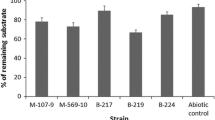Abstract
In the presence of sublethal concentrations of phenol, 4-chlorophenol, and p-cresol in the growth medium, cells of Escherichia coli modified the fatty acid composition of their lipids. The result of these changes was an increase in the degree of saturation of lipids probably in order to compensate an increase of fluidity of the membrane induced by the phenols. Supplementation of the growth medium with saturated fatty acids could also enhance the degree of lipid saturation due to the incorporation of the acyl chains in the phospholipids. At the same time the growth of cells was less inhibited than in unsupplemented cells. The increase of tolerance of cells by manipulating the lipid composition indicates that the membrane structure plays a crucial role in the mode of action of phenols.
Similar content being viewed by others
References
Black PN (1988) The fadL gene product of Escherichia coli is an outer membrane protein required for uptake of long-chain fatty acids and involved in sensitivity to bacteriophage T2. J Bacteriol 170: 2850–2854
Bligh EG, Dyer WJ (1959) A rapid method of total lipid extraction and purification. Can J Biochem Physiol 37: 911–917
Cronan JE (1968) Phospholipid alterations during growth of Escherichia coli. J Bacteriol 95: 2054–2061
Cronan JE, Rock CO (1987) Biosynthesis of membrane lipids. In: Neidhardt FC (ed) Escherichia coli and Salmonella typhimurium cellular and molecular biology, vol 1. American Society for Microbiology, Washington D.C., pp 474–497
Dombek KM, Ingram LO (1984) Effects of ethanol on the Escherichia coli plasma membrane. J Bacteriol 157: 233–239
Hamilton WA (1971) Membrane active antibacterial compounds. In: Hugo WB (ed) Inhibition and destruction of the microbial cell. Academic Press, New York, pp 77–93
Heipieper HJ, Keweloh H, Rehm HJ (1991) Influence of phenols on growth and membrane permeability of free and immobilized Escherichia coli. Appl Environ Microbiol 57: 1213–1217
Ingram LO (1976) Adaptation of membrane lipids to alkohols. J Bacteriol 125: 670–678
Ingram LO (1977) Changes in lipid composition of Escherichia coli resulting from growth with organic solvents and food additives. Appl Environ Microbiol 33: 1233–1236
Keweloh H, Heipieper HJ, Rehm HJ (1989) Protection of bacteria against toxicity of phenol by immobilization in calcium alginate. Appl Microbiol Biotechnol 31: 383–389
Keweloh H, Backhaus R, Weyrauch G, Heipieper HJ, Rehm HJ (1990a) Influence of phenols on the membrane of free and immobilized bacteria. Dechema — Biotechnol Conferences, vol 4. Verlag Chemie, Weinheim, pp 477–480
Keweloh H, Weyrauch G, Rehm HJ (1990b) Phenol-induced membrane changes in free and immobilized Escherichia coli. Appl Microbiol Biotechnol 33: 66–71
Maloy S, Ginsburgh C, Simons R, Nunn W (1981) Transport of long and medium chain fatty acids in E. coli. J Biol Chem 356: 3735–3742
Melchior DL (1982) Lipid phase transitions and regulation of membrane fluidity in prokaryotes. In: Razin S, Rottem S (eds) Current topics in membranes and transport, vol 17. Academic Press, New York, pp 263–316
Morrison WR, Smith LM (1964) Preparation of fatty acid methyl esters and dimethylacetals from lipids with boron fluoridemethanol. J Lipid Res 5: 600–608
Rock CO, Jackowski S (1985) Pathways for the incorporation of exogenous fatty acids into phosphatidylethanolamine in Escherichia coli. J Biol Chem 260: 12720–12724
Russell NJ, Fukunaga N (1990) A comparison of thermal adaptation of membrane lipids in psychrophilic and thermophilic bacteria. FEMS Microbiol Rev 75(2–3): 171–182
Shinitzky M (1984) Membrane fluidity and cellular functions. In: Shinitzky M (ed) Physiology of membrane fluidity, vol 1. CRC Press, Boca Raton, Florida, pp 1–52
Sinensky M (1971) Temperature control of phospholipid biosynthesis in Escherichia coli. J Bacteriol 106: 449–455
Sinensky M (1974) Homeoviscous adaptation — a homeostatic process that regulates the viscosity of membrane lipids in Escherichia coli. Proc Natl Acad Sci USA 71: 522–525
Author information
Authors and Affiliations
Rights and permissions
About this article
Cite this article
Keweloh, H., Diefenbach, R. & Rehm, HJ. Increase of phenol tolerance of Escherichia coli by alterations of the fatty acid composition of the membrane lipids. Arch. Microbiol. 157, 49–53 (1991). https://doi.org/10.1007/BF00245334
Received:
Accepted:
Issue Date:
DOI: https://doi.org/10.1007/BF00245334




